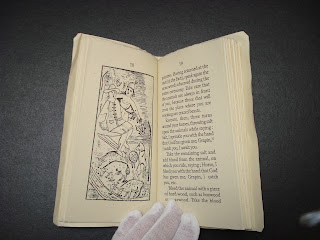Paperback, limited to 180 copies.
Magic Secrets is a collection of Norman folk-magic charms and remedies alleged recorded by a 17th century Cunning Man. The book states that it was originally published in 1670, though dates and authors were often exaggerated or fabricated in the grimoire tradition to imbue them with an air of authority or legitimacy. Its first known appearance was in the appendix of The Grimoire of Pope Honorious. In many ways it is perhaps a precursor to other small charm books, such as the Romanus Buchlein (1788) and Johann Georg Hohman's Long Lost Friend (1820). Like RB and LLF, Magic Secrets includes practical charms for the protection of livestock, charming of firearms, blood-stopping, reducing fevers, and instructions for creating protective wards and talismans. The vast majority of the book's charms are related to animal husbandry, such as charms for protecting sheep, or healing horses. This follows an earlier publication from The Society of Esoteric Endeavour, Society of the Horseman's Word, a book of equine charms detailing the practices of the legendary Scottish 'Horse Whisperers'. Magic Secrets also includes anonymous commentary discussing the history of the book and background of some of the charms.
The charms in Magic Secrets are largely written from a Christian perspective and often call upon the favor of Christ and angels. Considering the time and place of origin, this is hardly surprising. However, like many European grimoires, the book occasionally walks a fine line between piety and blasphemy. Blasphemous passages are written in Latin, presumably to hide their true meaning from others when spoken, as it would have certainly raised a few eyebrows, if not a few pyres. Sudden heretical statements, intended to deliver a shock, were occasionally used as a magical healing technique to perhaps scare or chase away unwanted malign spirits. One might compare it to wearing frightful masks to scare away evil spirits, especially on Halloween.
 |
| 'The Peddler' 17th century France |
In order to be historically accurate, the book is issued in paper wraps and has a somewhat rough-hewn binding. The cover is printed with a talismanic design and is waterproofed using an age-old method that involves rubbing the cover with beeswax and then burnishing it with a smooth stone, all done by hand of course. The paper is intentionally designed to have a rustic look and feel, much like the charms contained within. It is given a yap binding (an overlapping cover, often seen in older Bibles) and has clipped corners. According to the publisher, "Hahnemahle Medieval Laid 130 gsm paper" was chosen, as it closely resembles 17th century paper created with the mould-made production method. The linen texture of the paper is amazing. It feels very organic, and is flecked with natural fibers. Pages have a natural deckle edge at the top. The majority of copies (copies 1-154) have uncut pages, leaving it up to the reader to slice open each page with a pen-knife. Further adhering to tradition, the publisher chose to print Magic Secrets using lead type, an admirable but expensive decision. Though the publisher uses impressive printing methods and materials, the overall presentation of the book is very practical, including its size; it can easily be carried in a jacket pocket. This book isn't intended to be a show piece -- it's designed for use.
I have a tremendous respect for Ben Furnee, the mastermind behind The Society of Esoteric Endeavour's publications. His love for books and remarkable attention to historical detail, no matter how humble, comes through in each binding. When one holds one of his hand-bound books one also experiences his passion, conveyed powerfully through the the magic of the bookbinder's art. But be warned: his enthusiasm is contagious.






HI would you know of anyone who sells a reproduction of these books? I am looking for Magic Secrets attributed to Guidon (Translated from Norman French by Philippe Pissier and Book of Magic by Anon (Herbert Irwin) my email is bamphaknee@hotmail.com Would greatly appreciate any help
ReplyDelete